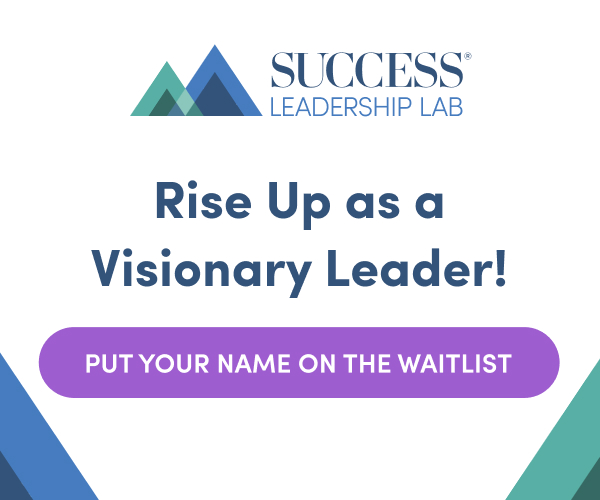What drives a successful organization?
Increasingly, leaders in industries where diversity has long lagged behind are holding up inclusion and equity as essential in a thriving workplace.
Change Catalyst CEO and author Melina Epler is one of those people leading the charge.
As a diversity and inclusion expert, Epler has given talks for such names as Google, McKinsey and The World Bank. She also hosts the popular podcast, Leading with Empathy and Allyship.
Now, with the publication of her book How to Be an Ally: Actions You Can Take for a Stronger, Happier Workplace, Epler details the actionable steps anyone can take to foster empathy and understanding in any organization.
“An ally is someone who puts empathy in action, at its core,” she says.
Recently, Epler sat down with SUCCESS to talk about the meaning of allyship, building equitable workspaces and engaging others with humanity.
Here are five key takeaways from her Achiever’s Exclusive interview that you can use in your personal and professional life.
1. Everyone has biases. Examine your own.
Even well-intended people can unintentionally cause harm without meaning to.
Epler identifies “in-group, out-group” biases based on affiliation or other characteristics as one of the most common in the workplace. This can be remedied by “being aware if you’re unintentionally excluding people by making some people feel like they’re not a part of that in-group.”
Another tool for overcoming biases? Self-regulation.
Epler suggests taking a moment when you first meet someone to ask yourself if you’re making assumptions about them that could prevent you from letting the person organically present themselves. This is especially important during the hiring process, Epler cautions.
“Are you looking at someone’s name and making assumptions before you’ve even met them, before you’ve even understood their experience?”
2. Learn to build consciousness.
Learning about historical issues with diversity is only part of the job. Building consciousness should involve stepping out of our bubbles.
Intentionally engaging with diverse points of view—interfacing with stories and perspectives that challenge our pre-construed narratives—is one of the biggest ways we can learn.
“Even in Hollywood, there’s a lack of representation within storytelling… and as a result, it changes our worldview,” Epler says. “And so we need to be conscious of that and make sure we’re consuming stories from different, diverse perspectives.”
3. Intervene when necessary.
Part of fostering inclusive spaces necessarily involves building teams that value empathy and growth. It also means standing up for inclusion by pushing back on behaviors that can undermine it.
One of those behaviors includes interrupting. Fortunately, it’s easy for other participants to butt in on those who would seek to monopolize airtime in conversations.
“If somebody is in a meeting and constantly being interrupted, stop the conversation, or if there’s a pause in the conversation for a minute, say, ‘Hey, you know, Melinda was trying to get a word in, and I’d love to hear what she has to say,’” Epler says. “It’s not that hard to make that kind of space.”
In other serious situations, such as when a racial slur is said, Epler recommends assuming good intentions first. Take the person aside, and explain without recriminating why that word or phrase can make others uncomfortable—even if it used to be perceived differently.
“The more that you can have that human, one-on-one interaction, the better in that scenario.”
4. Open your network to advocate for others.
As a leader, advocating for others is important—whether for them to have their work recognized or just gain access to new opportunities.
For Epler, one common example is that of the worker who’s not being recognized for their contributions. “Advocate for them to get a promotion, and notice when somebody is not being recognized for the work that they’ve been doing,” she says.
Opening your network to others who belong to groups that’ve been historically marginalized is another important way to advocate for greater diversity and inclusion.
“It could be that somebody has amazing skills and expertise, and they’re just not accessing the networks that they need to really grow in their career,” she says. “So use your influence to really open those networks or open your own networks for somebody else.”
5. Find other people’s unique access points to inclusion.
Not everyone comes to understand issues involving inclusion in the same way. Epler says it’s why it’s so important to “meet people where they are.”
For example, it can be useful to build a foundation of general empathy awareness before jumping into headfirst topics that can generate strong feelings, such as microaggressions.
“Everybody has their own entry-point into diversity, equity, inclusion and allyship. And so finding that motivation is the first step.”
People might be initially drawn to inclusion because they care about equality and justice, or it might just be because they just want to be the best leader possible.
In any case, when dealing with others who might be reluctant to talk about inclusion, Epler says it’s important to remember that “each of us is on our own journey.”
“There are different access points, and it’s really important to understand what those are—and to just remember that we’re all human.”
Photo by SeventyFour / Shutterstock











